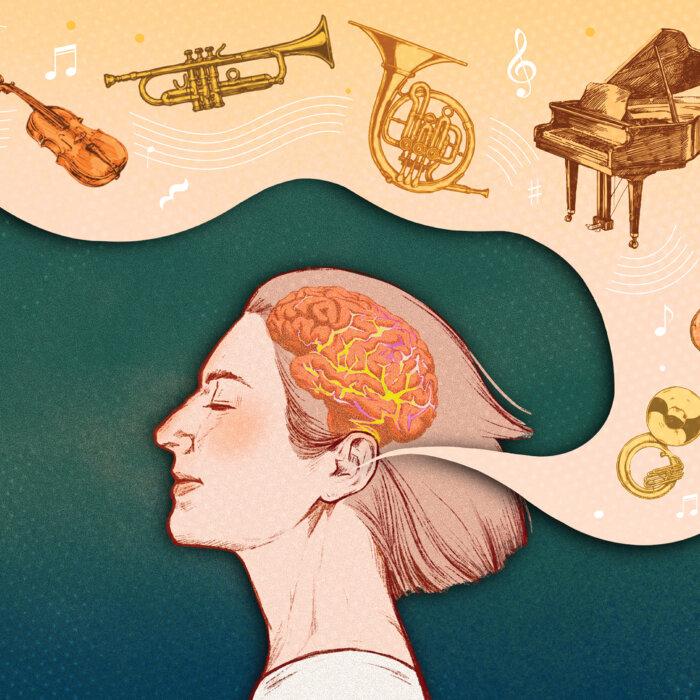On Nov. 24, 2019, a new thread titled “AirPods Causing Tinnitus?” appeared on the Apple community forum page.
The Apple user said that after using AirPods for a while, he noticed a high-pitched ringing in his ears that didn’t go away.
He said he had always been highly protective of his hearing; he didn’t listen to anything loud and always carried earplugs in case he encountered anything that could damage his hearing. But things only got worse.
“Having said all that, now I notice that when I put my AirPods in my ears and have nothing playing, they emit a high-pitched tone that I would say exactly replicates the tone of my tinnitus, leaving me to believe that the AirPods actually caused my tinnitus,” the user wrote.
The introduction of Apple wireless earphones has had a noticeable effect on earphone use, with younger generations using them more than older generations, said Julie Prutsman, an audiologist and founder of the Sound Relief Hearing Center. For the past few years, she has seen an increasing number of younger people show up to her clinics with hearing loss and tinnitus.
The audiologist told The Epoch Times that the root problem lies not with what earphones people use but with a common phenomenon: irresponsible use. The convenient wireless and noise-canceling features, along with better sound quality, have further exacerbated people’s overuse.
High ‘Dose’ and Prolonged Use
The American Osteopathic Association estimates that 20 percent of teenagers today will experience hearing loss, partially due to their headphone and earphone use. A review published in the International Journal of Audiology found that about 6 percent to 60 percent of earphone users show symptoms of hearing loss, including hearing difficulties and tinnitus.Most people know that loud sounds can damage the ears. However, Dr. Clarice Saba, a Brazilian otorhinolaryngologist, said listening at low volume for extended periods can also induce damage.
People put on their earphones at work, at home, and even during sleep. Even if the sounds may not always be loud, having earphones in for hours can still overwork the ears, Dr. Saba said.
The cochlea is located inside our ears. It sits behind the ear drum and is responsible for turning sound waves into electrical signals that are then transmitted to the brain. Prolonged use of earphones stresses and damages cochlear cells. If some of them die, hearing loss can occur.


Depending on the severity of the damage, the person may experience reduced sound sensitivity, problems with discerning sound, tinnitus, and even hearing loss.
Constantly keeping earphones in the ear canals can also cause a congested and humid environment, which may be conducive to ear infections. They also create greater in-ear pressure compared to over-ear headsets.
In-ear earphones, especially, rub against the delicate skin inside our ears.
“If you scratch the ear inadvertently while inserting the AirPods, there can be micro-breaks in the skin that can lead to infection,” Dr. Michael Seidman, an otolaryngologist, told The Epoch Times.
Besides, some people may not routinely clean their earphones, and debris on them can increase the risk. The earpieces also block most of the canal from outside oxygen, disrupting the health of the ear microbiome.
Noise Cancellation
In recent years, more noise-canceling earphones and headphones have hit the market, lending people the much-needed privacy to shield their music from those around them.However, noise cancellation comes with caveats.
Since these earphones silence environmental sounds, their prolonged use may lead to hyperacusis, a condition in which the brain’s tolerance for sound decreases so that even ambient environmental sounds, such as coughing or typing on the keyboard, can trigger a stressful response.

“People think, ‘I’m going to protect my hearing more.’ What they end up doing is actually causing their whole nervous system to overreact to normal levels of sound,” the audiologist said.
People with mild tinnitus may hardly notice the phantom sound when subtle background noises muffle the tinnitus in their environment. However, the high pitches can be more noticeable when a person is in a quiet environment, wearing ear protection, or using noise-canceling earphones.

Londoner Ryan Edwards, 45, told The Epoch Times that his tinnitus worsened after he switched to AirPod Pros, an updated version with a noise-cancellation feature, from AirPods.
Previously, Mr. Edwards’s tinnitus was like a soft “shhh” sound. Upon switching, he began noticing a second sound—louder and alarm-like. It disrupted his sleep and even concentration during the daytime.
After a process of elimination, Mr. Edwards confirmed his doubt about the new noise-canceling earphones.
“Anything that blocks hearing of natural outside sounds can trigger that perception of louder tinnitus,” Ms. Prutsman said.
However, some people with tinnitus do not find that noise-canceling earphones trigger their tinnitus. For these people, noise-canceling earphones can help reduce aggravating sounds and provide hearing comfort, the audiologist added.
Wireless Radiation
Wireless earphones, including AirPods, emit much lower levels of radiation than the Federal Communications Commission’s (FCC) limit of 1.6 watts per kilogram.The current guidelines for wireless radiation were established in 1996 and were made to limit radiation from phones so that it would not heat our skin.
However, three decades later, wireless products that give off radiation have become increasingly prevalent, and some researchers are starting to voice concerns that the radiation released by smartphones, Bluetooth products, and Wi-Fi modems may carry more harm than previously thought.
Bluetooth signals are weaker than Wi-Fi signals, and while they share similar frequencies, there is currently no direct evidence that Bluetooth can harm the ears or cells.

Ms. Prutsman said that Bluetooth earphones do seem to trigger some tinnitus patients. Some report softer-sounding tinnitus when they switch to wired earphones.
She explained that tinnitus makes people’s central nervous systems more sensitive.
Treatment and Prevention
The audiologist suggests that people use earphones with a maximum volume of 85 decibels, which is around the volume of a food blender or busy city traffic, to prevent hearing damage.

On the other hand, Dr. Saba recommends that people routinely remove their earphones at around two-hour intervals, even when used at low volumes. People with hearing loss and tinnitus can still use earphones if they limit their “doses.”
Dr. Seidman recommends that those concerned about ear infections wear over-ear headsets. Compared to headphones, earphones sit close to the eardrums, so they can also create greater pressure inside the ear canal, which may exacerbate hearing loss and headaches.
Though tinnitus is incurable, many treatments can help control the symptoms.
Ms. Prutsman’s clinic offers tinnitus retraining therapy, which involves having patients wear sound therapy earphones that play back the sound lost from hearing damage, helping to calm the overactive brain.
“Once we identify and replace that missing input to the brain, we can calm down some of the hyperactivity right away,” she said. The pitch is played back to the patient over relaxing, gentle sounds such as the ocean or instrumentals. The therapy takes six to 12 months.
Eventually, patients can be weaned off the therapy.
“But tinnitus is never completely gone. It’s just we can block the perception of it,” she added.
It’s also essential for tinnitus patients to identify their triggers. Tinnitus can be provoked by exposures that aggravate the nervous system, including caffeine, poor sleep, stress, infections, and loud noises, which are highly subjective. The audiologist shared that she has even had a case in which the smell of onions triggered a patient’s tinnitus.
Generally, maintaining a healthy lifestyle and diet helps. In his practice, Dr. Seidman monitors whether removing caffeine, sugar, and alcohol helps alleviate patients’ tinnitus.
He had a patient who drank only half a cup of coffee daily tell him: “You are not going to believe this, but I cut my half a cup of coffee, and my ringing went from a seven out of a 10 to a three.”
Hearing aids can treat hearing loss, but injectable steroids and vasodilators can help restore hearing in cases of sudden tinnitus and hearing loss.
Ginkgo biloba, which improves blood circulation, may also help patients with tinnitus, provided that the proper dose is given, Dr. Seidman said.
Mr. Edwards still uses the least fancy, non-noise-canceling version of AirPods, and his old problem hasn’t resurfaced. He manages his tinnitus by playing static noises interspersed with beeping sounds at night.
This is his 14th year with tinnitus. Like many others, he tried various therapies and every intervention under the sun before finally finding something that worked for him.
“I’ve got these crutches that I can use to alleviate it,“ he said. ”The sound therapy at night is an absolute lifesaver.”
Apple didn’t respond to The Epoch Times’ request for comment.















